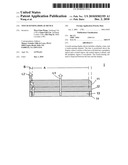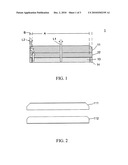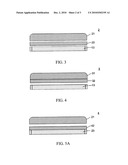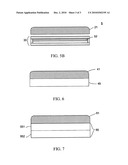Patent application title: TOUCH-SENSING DISPLAY DEVICE
Inventors:
Wen-Chun Wang (Taichung City, TW)
Chun-Chia Liu (Taichung County, TW)
Zhi-Ting Ye (Miao Licounty, TW)
IPC8 Class: AG06F3041FI
USPC Class:
345173
Class name: Computer graphics processing and selective visual display systems display peripheral interface input device touch panel
Publication date: 2010-12-02
Patent application number: 20100302195
evice includes a display, a lens, and a
touch-sensing element. The lens is positioned above the display, where a
surface of the lens is divided into a periphery region and a central
region, the central region is planar, and the periphery region is
non-planar. The touch-sensing element is disposed between the lens and
the display.Claims:
1. A touch-sensing display device, comprising:a display;a lens positioned
above the display, wherein a surface of the lens is divided into a
periphery region and a central region, the central region is planar, and
the periphery region is non-planar; anda touch-sensing element disposed
between the lens and the display.
2. The touch-sensing display device as claimed in claim 1, wherein the periphery region of the lens forms a curved surface.
3. The touch-sensing display device as claimed in claim 2, wherein the periphery region of the lens forms a partial spherical surface.
4. The touch-sensing display device as claimed in claim 1, wherein the periphery region of the lens forms an inclined plane.
5. The touch-sensing display device as claimed in claim 1, wherein the touch-sensing element is integrally formed under the lens as one piece.
6. The touch-sensing display device as claimed in claim 1, wherein the touch-sensing element is integrally formed on the display as one piece.
7. The touch-sensing display device as claimed in claim 1, wherein the touch-sensing element is integrally formed inside the display as one piece.
8. The touch-sensing display device as claimed in claim 1, wherein the touch-sensing element is a capacitive touch-sensing element, a resistive touch-sensing element, an optical touch-sensing element, or an ultrasonic touch-sensing element.
9. The touch-sensing display device as claimed in claim 1, further comprising an optical film formed on one surface of the lens facing the touch-sensing element.
10. The touch-sensing display device as claimed in claim 9, wherein the index of refraction of the optical film is smaller than the index of refraction of the lens.
11. The touch-sensing display device as claimed in claim 1, further comprising a plurality of optical films formed on one surface of the lens facing the touch-sensing element.
12. The touch-sensing display device as claimed in claim 11, wherein the optical film that is more close to the lens has a smaller index of refraction.Description:
BACKGROUND OF THE INVENTION
[0001](a) Field of the Invention
[0002]The invention relates to a touch-sensing display device having frameless visual effect.
[0003](b) Description of the Related Art
[0004]Typically, a conventional display has a non-active frame region that is formed on its periphery and fails to display images, and the frame region is reserved for assembly purposes or the placement of mechanisms. The existence of the frame region may deteriorate the visual effect of a display, and the visual effect is deteriorated to a greater extent as the area of the frame region becomes larger. Hence, there has been a recent trend towards a high-quality display having narrow-frame visual effect or even frameless visual effect.
BRIEF SUMMARY OF THE INVENTION
[0005]One object of the invention is to provide a touch-sensing display device capable of performing touch-sensing operations and having frameless visual effect.
[0006]According to an embodiment of the invention, a touch-sensing display device includes a display, a lens, and a touch-sensing element. The lens is positioned above the display, where a surface of the lens is divided into a periphery region and a central region, the central region is planar, and the periphery region is non-planar. The touch-sensing element is disposed between the lens and the display.
[0007]In one embodiment, the periphery region of the lens forms a curved surface or an inclined plane.
[0008]In one embodiment the touch-sensing element is integrally formed under the lens as one piece or integrally formed on the display as one piece.
[0009]In one embodiment, the touch-sensing display device further includes at least one optical film formed on one surface of the lens facing the touch-sensing element, and the index of refraction of the optical film is smaller than the index of refraction of the lens.
BRIEF DESCRIPTION OF THE DRAWINGS
[0010]FIG. 1 shows a schematic diagram of a touch-sensing display device according to an embodiment of the invention.
[0011]FIG. 2 shows a schematic diagram illustrating different shapes of a lens.
[0012]FIG. 3 shows a schematic diagram of a touch-sensing display device according to another embodiment of the invention.
[0013]FIG. 4 shows a schematic diagram of a touch-sensing display device according to another embodiment of the invention.
[0014]FIG. 5A shows a schematic diagram of a touch-sensing display device according to another embodiment of the invention.
[0015]FIG. 5B shows a schematic diagram of a touch-sensing display device according to another embodiment of the invention.
[0016]FIG. 6 shows a schematic diagram of a lens structure according to another embodiment of the invention.
[0017]FIG. 7 shows a schematic diagram of a lens structure according to another embodiment of the invention.
DETAILED DESCRIPTION OF THE INVENTION
[0018]FIG. 1 shows a schematic diagram of a touch-sensing display device according to an embodiment of the invention, where optical paths of image beams are indicated by arrows. Referring to FIG. 1, the touch-sensing display device 1 includes a lens 11, a display 13, and a touch-sensing element 12. The display 13 may be a liquid crystal display, an organic light-emitting diode display, a plasma display panel, or other type of display. The touch-sensing element 12 is disposed between the lens 11 and the display 13, and the touch-sensing element 12 may be a capacitive touch panel. The lens 11 is positioned above the touch-sensing element 12, and a surface of the lens is divided into a central region A and a periphery region B. The periphery region B and the central region A have mutually different surface shapes. For instance, the central region A is in the shape of a planar surface, and the periphery region B is in the shape of a curved surface. The curved shape of the periphery region B of the lens 11 allows to deflect image beams from the display 13 when the image beams pass through the periphery region B. More specifically, the image beams passing through the periphery region A propagate in an original optical path L1, but the image beams passing through the periphery region B are deflected to propagate in a modified optical path L2. Hence, the border frame 14 of the display 13 is no longer seen by an observer to achieve the frameless visual effect. Further, the touch-sensing element 12 between the lens 11 and the display 13 is capable of performing touch-sensing operations, and this plus the frameless visual effect results in a frameless touch-sensing display device.
[0019]FIG. 2 shows a schematic diagram illustrating different shapes of a lens. The shape of the periphery region of a lens may be selected according to the area of a border frame. For instance, referring to FIG. 2, a lens 111 having a periphery region in the shape of an inclined plane and a lens 112 having a periphery region in the shape of a curved surface are used in different embodiments. Further, the curved surface may a partial spherical surface or non-spherical surface. Besides, in case the periphery region is in the shape of an inclined plane, the slanted angle of the inclined plane may vary according to the area of the border frame. The lens 11 may be made of transparent plastic or transparent glass.
[0020]FIG. 3 and FIG. 4 each show schematic diagrams of a touch-sensing display device according to another embodiment of the invention. Referring to FIG. 3, the touch-sensing display device 2 may have a plug-in touch panel 22 disposed under a lens 21. Alternatively, referring to FIG. 4, in a touch-sensing display device 3 a touch-sensing element 32 is integrally formed under a lens 31 as one piece, with the lens 31 serving as a base plate and integrated with the touch-sensing element 32. Further, in an alternate embodiment shown in FIG. 5A, in a touch-sensing display device 4 a touch-sensing element 42 is integrally formed on a display 23 as one piece, with the display 23 serving as a base plate and integrated with the touch-sensing element 42. Also, referring to FIG. 5B, in a touch-sensing display device 5 a touch-sensing element 52 is integrally formed inside a display 33 as one piece, with the display 33 serving as a base plate. Note the touch-sensing element may be a capacitive touch-sensing element, a resistive touch-sensing element, an optical touch-sensing element, an ultrasonic touch-sensing element, etc.
[0021]FIG. 6 shows a schematic diagram of a lens structure according to another embodiment of the invention. Referring to FIG. 6, in contrast to the embodiment shown in FIG. 1, the lens 41 is coated with an optical film 45 having high index of refraction on its one surface facing the touch-sensing element, where the index of refraction of the optical film 45 is smaller than the index of refraction of the lens 41. The material of the lens 41 includes, but is not limited to, transparent glass or transparent plastic. The formation of an optical film allows to change the optical paths of image beams to a greater extent, thus reducing the lens thickness and overall occupied space. Similarly, the touch-sensing display device in this embodiment may have a plug-in touch panel disposed under a lens, or a touch-sensing element is integrally formed under a lens as one piece, with the lens serving as a base plate and integrated with the touch-sensing element. Alternatively, a touch-sensing element is integrally formed on a display as one piece, with the display serving as a base plate and integrated with the touch-sensing element. The touch-sensing element in this embodiment may be a capacitive touch-sensing element, a resistive touch-sensing element, an optical touch-sensing element, an ultrasonic touch-sensing element, etc.
[0022]FIG. 7 shows a schematic diagram of a lens structure according to another embodiment of the invention. Referring to FIG. 7, in contrast to the embodiment shown in FIG. 6, the lens 55 is coated with at least two optical films 55, and the optical film 55 that is more close to the lens 55 has a smaller index of refraction so as to change the paths of image beams to a greater extent. In this embodiment, the lens 55 is coated with a first optical film 551 and a second optical film 552, and the index of refraction of the first optical film 551 is smaller than that of the second optical film 552. Such design may further reduce the lens thickness and overall occupied space. Further, the material of the lens 51 includes, but is not limited to, transparent glass or transparent plastic. Similarly, the touch-sensing display device in this embodiment may have a plug-in touch panel disposed under a lens, or a touch-sensing element is integrally formed under a lens as one piece, with the lens serving as a base plate and integrated with the touch-sensing element. Alternatively, a touch-sensing element is integrally formed on a display as one piece, with the display serving as a base plate and integrated with the touch-sensing element. The touch-sensing element in this embodiment may be a capacitive touch-sensing element, a resistive touch-sensing element, an optical touch-sensing element, an ultrasonic touch-sensing element, etc.
[0023]Although the present invention has been fully described by the above embodiments, the embodiments should not constitute the limitation of the scope of the invention. Various modifications or changes can be made by those who are skilled in the art without deviating from the spirit of the invention.
Claims:
1. A touch-sensing display device, comprising:a display;a lens positioned
above the display, wherein a surface of the lens is divided into a
periphery region and a central region, the central region is planar, and
the periphery region is non-planar; anda touch-sensing element disposed
between the lens and the display.
2. The touch-sensing display device as claimed in claim 1, wherein the periphery region of the lens forms a curved surface.
3. The touch-sensing display device as claimed in claim 2, wherein the periphery region of the lens forms a partial spherical surface.
4. The touch-sensing display device as claimed in claim 1, wherein the periphery region of the lens forms an inclined plane.
5. The touch-sensing display device as claimed in claim 1, wherein the touch-sensing element is integrally formed under the lens as one piece.
6. The touch-sensing display device as claimed in claim 1, wherein the touch-sensing element is integrally formed on the display as one piece.
7. The touch-sensing display device as claimed in claim 1, wherein the touch-sensing element is integrally formed inside the display as one piece.
8. The touch-sensing display device as claimed in claim 1, wherein the touch-sensing element is a capacitive touch-sensing element, a resistive touch-sensing element, an optical touch-sensing element, or an ultrasonic touch-sensing element.
9. The touch-sensing display device as claimed in claim 1, further comprising an optical film formed on one surface of the lens facing the touch-sensing element.
10. The touch-sensing display device as claimed in claim 9, wherein the index of refraction of the optical film is smaller than the index of refraction of the lens.
11. The touch-sensing display device as claimed in claim 1, further comprising a plurality of optical films formed on one surface of the lens facing the touch-sensing element.
12. The touch-sensing display device as claimed in claim 11, wherein the optical film that is more close to the lens has a smaller index of refraction.
Description:
BACKGROUND OF THE INVENTION
[0001](a) Field of the Invention
[0002]The invention relates to a touch-sensing display device having frameless visual effect.
[0003](b) Description of the Related Art
[0004]Typically, a conventional display has a non-active frame region that is formed on its periphery and fails to display images, and the frame region is reserved for assembly purposes or the placement of mechanisms. The existence of the frame region may deteriorate the visual effect of a display, and the visual effect is deteriorated to a greater extent as the area of the frame region becomes larger. Hence, there has been a recent trend towards a high-quality display having narrow-frame visual effect or even frameless visual effect.
BRIEF SUMMARY OF THE INVENTION
[0005]One object of the invention is to provide a touch-sensing display device capable of performing touch-sensing operations and having frameless visual effect.
[0006]According to an embodiment of the invention, a touch-sensing display device includes a display, a lens, and a touch-sensing element. The lens is positioned above the display, where a surface of the lens is divided into a periphery region and a central region, the central region is planar, and the periphery region is non-planar. The touch-sensing element is disposed between the lens and the display.
[0007]In one embodiment, the periphery region of the lens forms a curved surface or an inclined plane.
[0008]In one embodiment the touch-sensing element is integrally formed under the lens as one piece or integrally formed on the display as one piece.
[0009]In one embodiment, the touch-sensing display device further includes at least one optical film formed on one surface of the lens facing the touch-sensing element, and the index of refraction of the optical film is smaller than the index of refraction of the lens.
BRIEF DESCRIPTION OF THE DRAWINGS
[0010]FIG. 1 shows a schematic diagram of a touch-sensing display device according to an embodiment of the invention.
[0011]FIG. 2 shows a schematic diagram illustrating different shapes of a lens.
[0012]FIG. 3 shows a schematic diagram of a touch-sensing display device according to another embodiment of the invention.
[0013]FIG. 4 shows a schematic diagram of a touch-sensing display device according to another embodiment of the invention.
[0014]FIG. 5A shows a schematic diagram of a touch-sensing display device according to another embodiment of the invention.
[0015]FIG. 5B shows a schematic diagram of a touch-sensing display device according to another embodiment of the invention.
[0016]FIG. 6 shows a schematic diagram of a lens structure according to another embodiment of the invention.
[0017]FIG. 7 shows a schematic diagram of a lens structure according to another embodiment of the invention.
DETAILED DESCRIPTION OF THE INVENTION
[0018]FIG. 1 shows a schematic diagram of a touch-sensing display device according to an embodiment of the invention, where optical paths of image beams are indicated by arrows. Referring to FIG. 1, the touch-sensing display device 1 includes a lens 11, a display 13, and a touch-sensing element 12. The display 13 may be a liquid crystal display, an organic light-emitting diode display, a plasma display panel, or other type of display. The touch-sensing element 12 is disposed between the lens 11 and the display 13, and the touch-sensing element 12 may be a capacitive touch panel. The lens 11 is positioned above the touch-sensing element 12, and a surface of the lens is divided into a central region A and a periphery region B. The periphery region B and the central region A have mutually different surface shapes. For instance, the central region A is in the shape of a planar surface, and the periphery region B is in the shape of a curved surface. The curved shape of the periphery region B of the lens 11 allows to deflect image beams from the display 13 when the image beams pass through the periphery region B. More specifically, the image beams passing through the periphery region A propagate in an original optical path L1, but the image beams passing through the periphery region B are deflected to propagate in a modified optical path L2. Hence, the border frame 14 of the display 13 is no longer seen by an observer to achieve the frameless visual effect. Further, the touch-sensing element 12 between the lens 11 and the display 13 is capable of performing touch-sensing operations, and this plus the frameless visual effect results in a frameless touch-sensing display device.
[0019]FIG. 2 shows a schematic diagram illustrating different shapes of a lens. The shape of the periphery region of a lens may be selected according to the area of a border frame. For instance, referring to FIG. 2, a lens 111 having a periphery region in the shape of an inclined plane and a lens 112 having a periphery region in the shape of a curved surface are used in different embodiments. Further, the curved surface may a partial spherical surface or non-spherical surface. Besides, in case the periphery region is in the shape of an inclined plane, the slanted angle of the inclined plane may vary according to the area of the border frame. The lens 11 may be made of transparent plastic or transparent glass.
[0020]FIG. 3 and FIG. 4 each show schematic diagrams of a touch-sensing display device according to another embodiment of the invention. Referring to FIG. 3, the touch-sensing display device 2 may have a plug-in touch panel 22 disposed under a lens 21. Alternatively, referring to FIG. 4, in a touch-sensing display device 3 a touch-sensing element 32 is integrally formed under a lens 31 as one piece, with the lens 31 serving as a base plate and integrated with the touch-sensing element 32. Further, in an alternate embodiment shown in FIG. 5A, in a touch-sensing display device 4 a touch-sensing element 42 is integrally formed on a display 23 as one piece, with the display 23 serving as a base plate and integrated with the touch-sensing element 42. Also, referring to FIG. 5B, in a touch-sensing display device 5 a touch-sensing element 52 is integrally formed inside a display 33 as one piece, with the display 33 serving as a base plate. Note the touch-sensing element may be a capacitive touch-sensing element, a resistive touch-sensing element, an optical touch-sensing element, an ultrasonic touch-sensing element, etc.
[0021]FIG. 6 shows a schematic diagram of a lens structure according to another embodiment of the invention. Referring to FIG. 6, in contrast to the embodiment shown in FIG. 1, the lens 41 is coated with an optical film 45 having high index of refraction on its one surface facing the touch-sensing element, where the index of refraction of the optical film 45 is smaller than the index of refraction of the lens 41. The material of the lens 41 includes, but is not limited to, transparent glass or transparent plastic. The formation of an optical film allows to change the optical paths of image beams to a greater extent, thus reducing the lens thickness and overall occupied space. Similarly, the touch-sensing display device in this embodiment may have a plug-in touch panel disposed under a lens, or a touch-sensing element is integrally formed under a lens as one piece, with the lens serving as a base plate and integrated with the touch-sensing element. Alternatively, a touch-sensing element is integrally formed on a display as one piece, with the display serving as a base plate and integrated with the touch-sensing element. The touch-sensing element in this embodiment may be a capacitive touch-sensing element, a resistive touch-sensing element, an optical touch-sensing element, an ultrasonic touch-sensing element, etc.
[0022]FIG. 7 shows a schematic diagram of a lens structure according to another embodiment of the invention. Referring to FIG. 7, in contrast to the embodiment shown in FIG. 6, the lens 55 is coated with at least two optical films 55, and the optical film 55 that is more close to the lens 55 has a smaller index of refraction so as to change the paths of image beams to a greater extent. In this embodiment, the lens 55 is coated with a first optical film 551 and a second optical film 552, and the index of refraction of the first optical film 551 is smaller than that of the second optical film 552. Such design may further reduce the lens thickness and overall occupied space. Further, the material of the lens 51 includes, but is not limited to, transparent glass or transparent plastic. Similarly, the touch-sensing display device in this embodiment may have a plug-in touch panel disposed under a lens, or a touch-sensing element is integrally formed under a lens as one piece, with the lens serving as a base plate and integrated with the touch-sensing element. Alternatively, a touch-sensing element is integrally formed on a display as one piece, with the display serving as a base plate and integrated with the touch-sensing element. The touch-sensing element in this embodiment may be a capacitive touch-sensing element, a resistive touch-sensing element, an optical touch-sensing element, an ultrasonic touch-sensing element, etc.
[0023]Although the present invention has been fully described by the above embodiments, the embodiments should not constitute the limitation of the scope of the invention. Various modifications or changes can be made by those who are skilled in the art without deviating from the spirit of the invention.
User Contributions:
Comment about this patent or add new information about this topic:
| People who visited this patent also read: | |
| Patent application number | Title |
|---|---|
| 20100310543 | METHOD OF PREVENTING AND TREATING ACUTE BRAIN PATHOLOGIES |
| 20100310542 | Pharmaceutical Compositions for treating wouds and related methods |
| 20100310541 | Compositions and Methods for Reducing the Toxicity of Certain Toxins |
| 20100310540 | METHODS OF SCREENING FOR COMPOUNDS THAT MODULATE TAFIA ACTIVITY, COMPOUNDS, AND METHODS OF USING THE COMPOUNDS |
| 20100310539 | METHOD FOR MANUFACTURING MESOPOROUS MATERIALS, MATERIALS SO PRODUCED AND USE OF MESOPOROUS MATERIALS |




